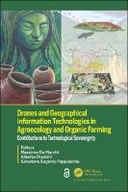Explore

Drones and Geographical Information Technologies in Agroecology and Organic Farming
0 Ungluers have
Faved this Work
Login to Fave
Although organic farming and agroecology are normally not associated with the use of new technologies, it’s rapid growth, new technologies are being adopted to mitigate environmental impacts of intensive production implemented with external material and energy inputs. GPS, satellite images, GIS, drones, help conventional farming in precision supply of water, pesticides, fertilizers. Prescription maps define the right place and moment for interventions of machinery fleets. Yield goal remains the key objective, integrating a more efficient use or resources toward an economic-environmental sustainability. Technological smart farming allows extractive agriculture entering the sustainability era. Societies that practice agroecology through the development of human-environmental co-evolutionary systems represent a solid model of sustainability. These systems are characterized by high-quality agroecosystems and landscapes, social inclusion, and viable economies.
This book explores the challenges posed by the new geographic information technologies in agroecology and organic farming. It discusses the differences among technology-laden conventional farming systems and the role of technologies in strengthening the potential of agroecology. The first part reviews the new tools offered by geographic information technologies to farmers and people. The second part provides case studies of most promising application of technologies in organic farming and agroecology: the diffusion of hyperspectral imagery, the role of positioning systems, the integration of drones with satellite imagery. The third part of the book, explores the role of agroecology using a multiscale approach from the farm to the landscape level. This section explores the potential of Geodesign in promoting alliances between farmers and people, and strengthening food networks, whether through proximity urban farming or asserting land rights in remote areas in the spirit of agroecological transition.
The Open Access version of this book, available at www.taylorfrancis.com, has been made available under a Creative Commons 4.0 license.
This book is included in DOAB.
Why read this book? Have your say.
You must be logged in to comment.
Rights Information
Are you the author or publisher of this work? If so, you can claim it as yours by registering as an Unglue.it rights holder.Downloads
This work has been downloaded 103 times via unglue.it ebook links.
- 103 - pdf (CC BY-NC-ND) at OAPEN Library.
Keywords
- Agriculture & Farming
- Agriculture and farming
- Biology, Life Sciences
- Botany & plant sciences
- Botany and plant sciences
- Forestry & silviculture: practice & techniques
- Forestry and silviculture: practice and techniques
- Geographical information systems (GIS) & remote sensing
- Geographical information systems and remote sensing
- Geography
- Mathematics & science
- Technology, engineering, agriculture
- thema EDItEUR::P Mathematics and Science::PS Biology, life sciences
- thema EDItEUR::P Mathematics and Science::PS Biology, life sciences::PST Botany and plant sciences
Links
DOI: 10.1201/9780429052842Editions

